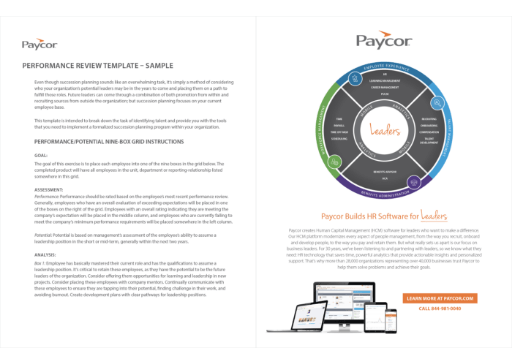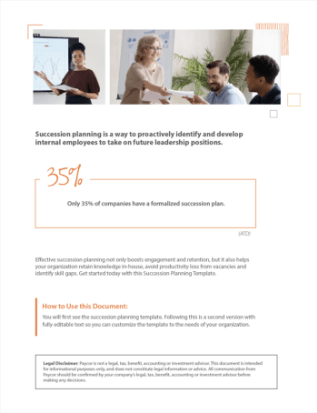Plan For The Future With Talent You Have
Every great business plans for the future —from budgeting and prospecting to identifying new services. While it’s important to look forward, it can understandably be difficult to envision the future when you are just making it through the day. But that planning is vital. It’s important to plan for business in the future and it’s equally important to plan for the future of your business.
In this article, we’ll look at how you can use a succession plan and a winning team to secure both plans. And we’ll provide you with a succession planning template to get started.
What is Succession Planning?
Succession planning is the act of identifying positions that are required to meet the short and long-term goals of an organization. Once key roles and necessary skills are identified, leaders can prepare individuals for those key positions through development, training and action plans.
It’s important to remember that succession planning isn’t just about the future. It’s also about the now.
Related Article: What is the Role of HR in Succession Planning?
How Succession Planning Works
Some businesses look at succession planning as creating a “Next in Line” org chart. While that’s part of the process, to be effective a succession plan needs to be broader. Succession plans work when they are complete and breathable.
- Complete: Succession planning is built on a foundation of understanding. Understanding the roles in a company and the skills those roles need for success now. Understanding where the company is headed, the roles that will be needed there and the skills needed for those roles to be successful in the future.
- Breathable: Do you have a succession plan? How old is it? How much has the company/industry/workforce changed since it was established? Succession plans should be looked at as active, living, breathable documents. That said, they don’t need to be adjusted for every little change in the company but for them to work when needed, they need to be representative of the current state of the business.
All In for Success
It’s very important that potential leadership candidates know they are part of a succession plan as they will need to be willing to participate in the development process. The succession planning process involves more than just getting things on paper, it will require training, coaching, mentorship and assignments outside of regular job descriptions.
Additionally, when employees know their skills are valued, it can help prevent them from leaving.
Five-Step Process in Succession Planning
You’re wondering: “How can my organization make an effective succession plan?” Succession planning is about more than filling key roles. Success involves a five-step process:
- Understand Future Business Challenges and Needs
Will your organization be offering new products and services in the next few years? Expanding into new markets or industries?
Creating a clear vision for the future will help you identify what future leaders will need. - Determine Which Skills are Required for Leadership Roles
Based on the assessment of where you are and where you’re going, do you need leaders with managerial experience or professionals with specific expertise?
Understanding this list of skills will impact the assignments you give to potential leadership candidates. - Evaluate Current Talent Pool for Potential
Align with other leaders on the pool of candidates who should be considered for future positions. To help, we’ve provided a Succession Planning Template to help you identify those candidates. - Develop a Plan to Help Internal Candidates Develop Skills
Once you know what potential leadership candidates will need for the future of the organization, your leadership team can begin to provide projects, roles and responsibilities that help those candidates build the necessary skills. - Evaluate Progress Along the Way
Be sure to keep track of how candidates are developing. This can be done in 1-on-1 meetings, quarterly performance reviews or within a talent development platform.
But you don’t have to go at this with a blank piece of paper and a few hazy ideas. We’ve provided a customizable business Succession Plan Template to help you begin preparing for a leadership transition.
Why Succession Planning is Important
The talent war is far from over. Benefits, bonuses and creative perks can help, but you still need creative ways to retain your most valuable employees. For example, have you considered including them in your organization’s future through succession planning?
69% of workers prefer to have career growth and development opportunities in a job (Gallup).
94% of employers who executed succession plans agreed that the process positively affected employee engagement scores.
Effective succession planning not only boosts engagement and retention, it also helps your organization:
- retain knowledge in-house
- establish a talent pipeline
- avoid productivity losses from vacancies
- identify skill gaps
- maintain development plans
- keep critical roles staffed
Risks of Not Having a Succession Plan
Not having a succession plan in place opens the company up to a number of risks.
- Loss of historical knowledge
- Loss of customer/client relational knowledge and trust
- Workflow and project disruptions
- Incurring costs (financial and time) in finding, hiring and onboarding positions
- Loss of trust in the company
- Delay of key business decisions
- Employee frustration and unhappiness with a “rudder-less company”
- Unintentionally sending the company in the wrong direction because the wrong person was elevated
Who Creates a Succession Plan
Succession planning goes hand in hand with talent development more generally, which puts HR at the center of the story. Managers have a big part to play in spotting and training future superstars, but HR has the skills and oversight to take a broader approach to succession planning.
If you have a succession plan, now is when you should revisit it. Start here.











